Shaving Before FUE Transplant
In preparation for a scalp to scalp FUE procedure, there are different options for shaving or trimming when it comes to both recipient and donor areas. The decision about shaving or not shaving is usually one of the most important choices any patient makes in preparation of a FUE procedure.
Recipient Shaving
Shaving is usually not mandatory before a hair restoration for the recipient (balding) area. If patients don’t have much hair in the recipient area, shaving is not even discussed. However, when there is preexisting hair in the recipient area (such as the front and corners) that we are planning to transplant, we may suggest shaving or trimming. There are times when a shaved head is easier to work with. The doctor can make the sites easier and the surgical team can implant the grafts into the sites more efficiently.
Take the first step towards your hair transformation.
Fill in the form to begin your life-changing hair restoration journey today!
People often decide to shave the recipient area when:
- They want to shave the donor area on the back and want all areas to match
- Prefer to save on the hair transplant cost as opposed to Celebrity FUE™ (Non-Shaven FUE)
- They want to maximize the preciseness of the transplantation
Donor Shaving Options
Shaving the donor area before FUE hair transplant offers different options based on the patient’s priorities, lifestyle and the projected downtime. Patient options for shaving or not shaving range from not shaving the area at all to partial trimming to completely shaving the area. At times, we can be creative and limit the shaving to the areas we need to have access to and the rest of the patient’s scalp hair can comb over the shaved area and cover the area.
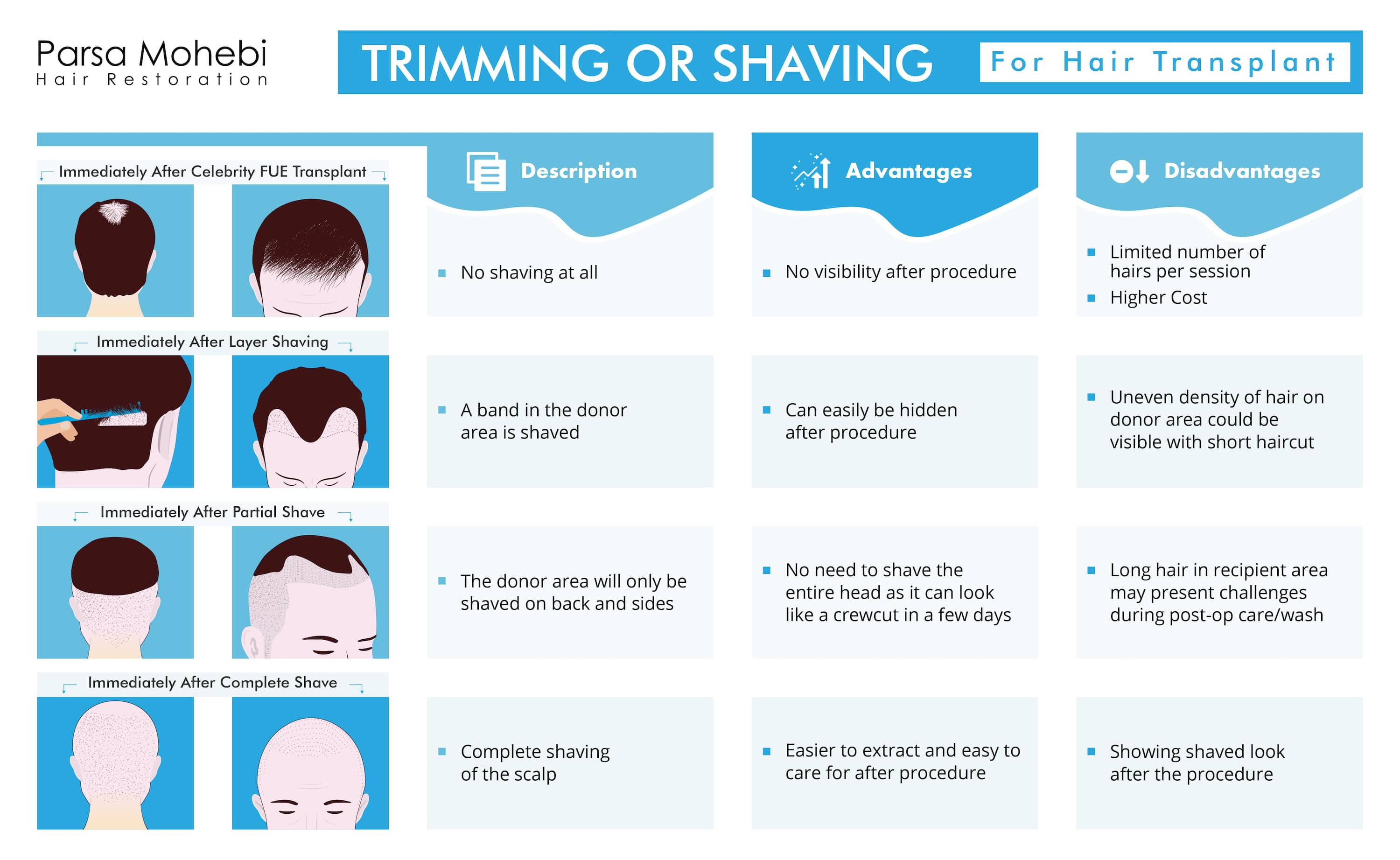
Celebrity FUE Transplant™
Celebrity FUE™ (non-shaven FUE) is when we don’t shave or trim any hair before a FUE procedure. The follicular units that were to be extracted are either cut individually or long hair is removed with Trivellini LongHair System.
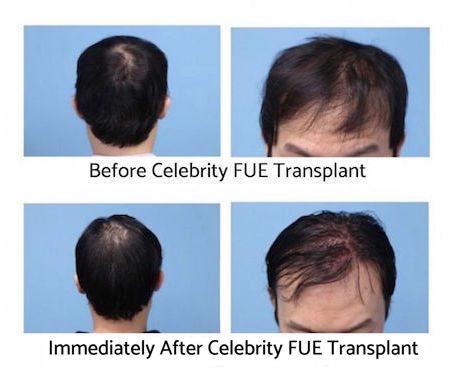
Patients can walk out of the office after Celebrity FUE™ without any evidence of the procedure. If the transplanted area is exposed, there might still be some redness or scabbing but they may not be as noticeable for the patient as long as they don’t have to shave.
Celebrity FUE™ is more labor intensive and time consuming and the number of grafts may be more limited. For the same reason, the cost of Celebrity FUE Transplant™ is usually higher than the cost of a normal FUE. This is an ideal procedure for patients who have a busy lifestyle and do not want any detectable evidence from a hair transplant procedure.
Layer shaving or trimming
Layer shaving or band trimming is very common among women or men who have longer hair. Having longer hair allows the operator to trim only the areas of the scalp that needs to be used to harvest grafts. The shaving can be done in one or two parallel bands on the patient’s donor area that extends from ear to ear.
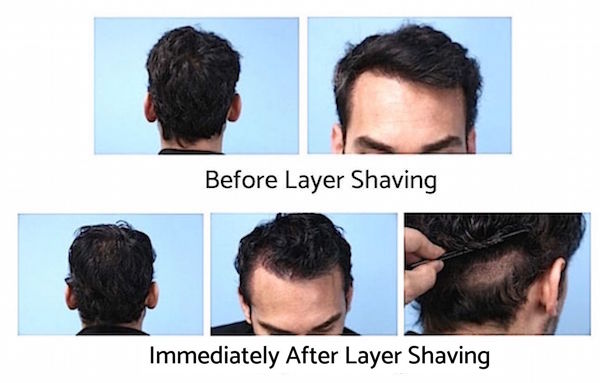
After the procedure, the hair is combed down and the combed hair can easily cover the shaved area. This is a good alternative for patients who want to avoid the shaved look without the need to pay the higher cost of a Celebrity FUE™.
Hair in the trimmed area will continue to grow and, after 2 -4 weeks, gives a very good coverage (0.5 – 1 CM hair length). The donor shaving won’t be visible even if the hair is parted or cut short on the back.
Partial Shave before FUE Hair Transplant
A common question before patients undergo a hair transplant is patients asking if they need to shave their head before having the procedure. FUE hair transplant can be performed by only partially shaving the head since people tend to see their hair as part of their identity and completely shaving it might impact their self-confidence.
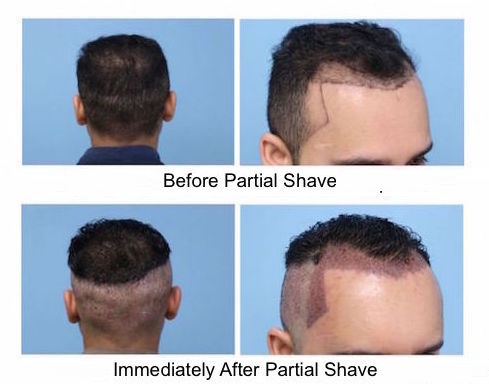
A partial shave before FUE hair transplant can be done in layers. This allows the longer neighboring hair, located above or next to the shaved area, to fall over and cover the area that is partially shaved.
Partial shave before FUE hair transplant allows patients to maintain their existing hair in the same style and length as before the procedure. In addition, a partial shave before FUE makes it less obvious that a hair transplant took place so patients can return to work shortly after the hair transplant.
Complete Shaving
Shaving the scalp on the donor area helps to speed up the procedure and makes it easier for wash and care for the hair after the procedure. It can also reduce the cost of the procedure in comparison to a Celebrity FUE Hair Transplant™ in which shaving will not be done on the donor or recipient area.
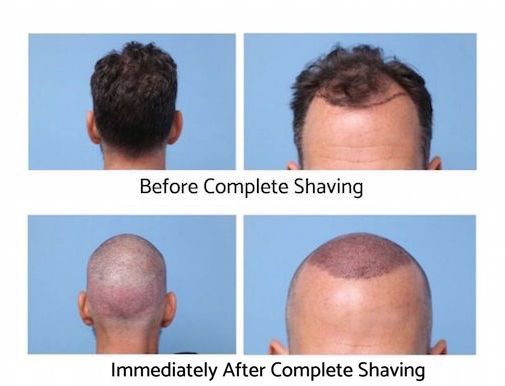
Patients who opt to go with the shaved option usually see some growth in the transplanted grafts after the first week. That is the time that the preexisting hair is also grown to match the length of the transplanted hair. Two weeks after the transplant day, the patient usually shows the appearance of a complete crew cut without any evidence of balding on the transplanted area.
We consider your lifestyle
Our procedures include different options for people with different lifestyles. Although some patients can wear a hat after their procedure to hide any shaving or trimming, others may not be able to make any changes due to their demanding lifestyle.
The best way to decide about trimming, shaving or not shaving is to schedule a hair transplant consultation with us. We will review your options based on the size of the hair transplant and your health. We consider other options such as using head wears, concealers or altering hairstyles to minimize the visibility of the scalp after a hair transplant procedure.